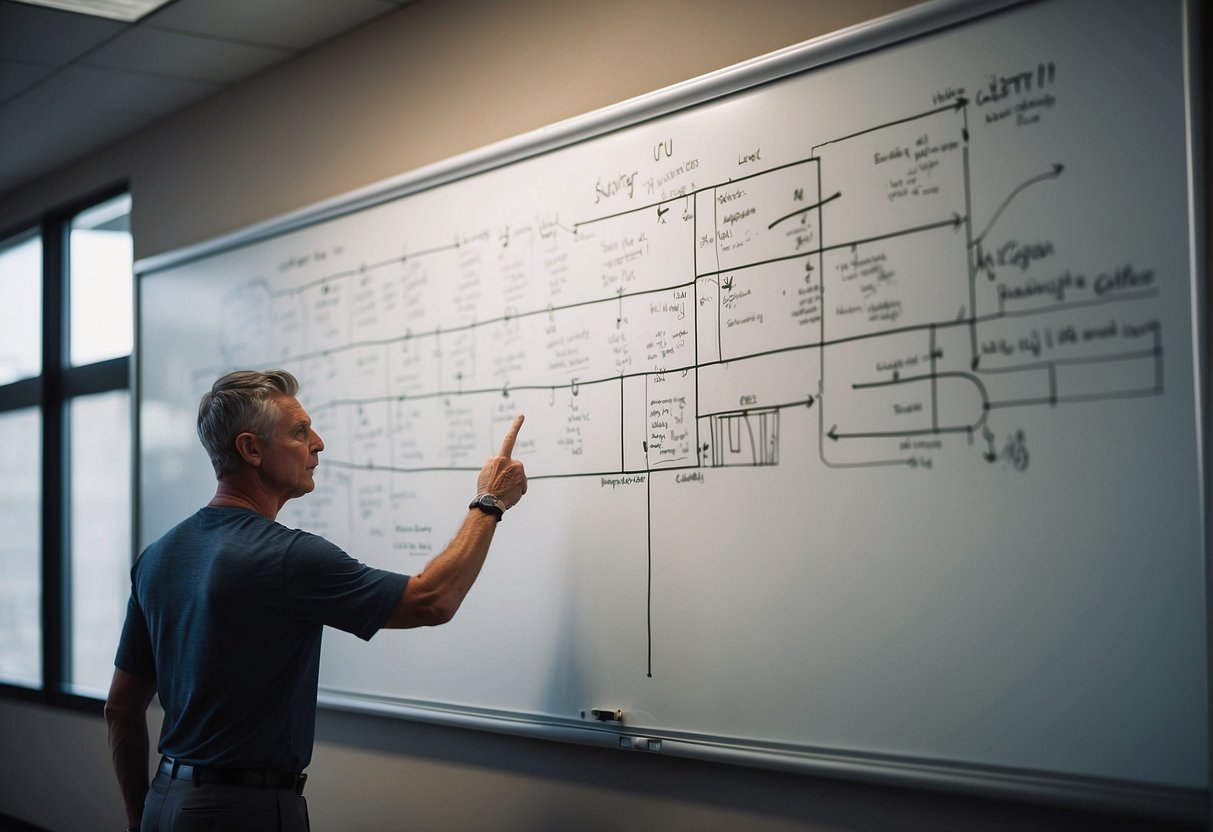Empower yourself as a basketball coach with my expert insights into how to coach basketball effectively. From honing player skills to crafting winning strategies, learn from my seasoned experience the essential techniques for guiding your team to victory.
How to Coach Basketball: Getting Started
Understand the Role of a Basketball Coach
As a basketball coach, you are not just a mentor but also a leader tasked with developing players’ skills, fostering teamwork, and instilling sportsmanship. Your responsibilities include strategizing game plays, conducting practice sessions, and making crucial in-game decisions. Moreover, connecting with players and fostering a positive team environment are pivotal aspects of your role.
Developing Your Coaching Philosophy
Your coaching philosophy is a set of values and principles that guide how you manage your team and make coaching decisions. It should reflect your approach to discipline, how you define success, and your methodology in teaching the game. To develop this, consider your experiences with past coaches, your observations of coaching styles, and what you believe to be the best approach to coaching basketball.
Completing the Necessary Certifications
Before leading a team, you generally need to complete specific certifications. These vary by level and region but often include:
- First aid and CPR training to ensure player safety
- Coaching certification programs recognized by relevant sports authorities or educational institutions
Remember, volunteering at local leagues or schools and networking with established coaches can open doors to coaching positions and crucial learning opportunities as you become a coach.
Fundamentals of Basketball Coaching
To excel at coaching basketball, you need a solid understanding of the game’s fundamentals and a strategic approach toward instilling these skills in your players. This involves honing their basketball skills through targeted drills and well-structured practice plans.
Teaching Basketball Fundamentals
Your primary role as a coach is to teach basketball fundamentals like ball handling, shooting, and passing. Emphasize the importance of footwork and proper body mechanics, as they are crucial for success on the court. For younger players, keep instructions simple and demonstrate techniques. The basics of shooting include proper foot alignment and arm angle, while effective passing requires teaching players about timing and spatial awareness.
Skill Development Drills
To develop your team’s basketball skills, incorporate a variety of drills that focus on specific abilities. For example, use cone drills to enhance dribbling skills and shooting exercises to improve accuracy and form. Balance is key; ensure players practice both offensive and defensive skills. When introducing new drills, demonstrate them first, then observe and correct players’ techniques to reinforce proper mechanics. Adjust drills to match skill levels and keep practices engaging.
Creating Effective Practice Plans
An effective practice plan is structured and adaptable, allocating time for warm-up, skill drills, tactical exercises, and cool-downs. Start by identifying objectives for each practice, then select drills that align with those goals. For youth basketball, it’s crucial to include fun activities that keep players motivated while learning. Incorporate scrimmages to apply skills in a game setting, but always leave room for flexibility based on how your team is progressing.
Building a Team Mindset

In coaching basketball, it’s essential to instill a strong sense of unity and collaboration. Your role is to weave individual talents into a cohesive fabric that values cooperation as much as it does skill.
Fostering Teamwork and Communication
Teamwork: To cultivate teamwork, start by establishing clear roles and responsibilities. Use activities that require players to work together to succeed. For example:
- Passing Drills: Encourage players to communicate verbally and non-verbally to pass the ball effectively.
- Team Challenges: Create situations where players must rely on each other to overcome obstacles.
Emphasize the importance of active listening and open dialogue. Doing this fosters an environment where players are comfortable sharing insights and strategies, which can enhance on-court performance.
Understanding Team Dynamics
Understanding the unique blend of personalities and skills on your team is crucial. Pay attention to how players interact during practice planning and games to gauge the team’s dynamics. Here’s what you can do:
- Identify leaders who positively influence others.
- Recognize the varying motivation levels and work to align them with the team’s goals.
Promoting a Positive Team Environment
A positive team environment is a foundation for success. To promote this:
- Celebrate small victories to build confidence.
- Cultivate a growth mindset via positive reinforcement.
Make sure fun is a part of the team’s experience. A fun atmosphere can boost motivation and make the hard work of practice more enjoyable, fostering a more robust team bond.
Designing Basketball Plays and Strategies

To excel in basketball coaching, you need a deep understanding of offensive and defensive strategies. Your plays should maximize each player’s strengths and create opportunities for your team to score, while your defensive schemes should focus on disrupting the opponent’s flow and forcing errors.
Establishing Offensive Plays
Start by designing motion offense plays that encourage player movement and provide options. Movement off the ball, including its use, is crucial. Here’s a straightforward approach to structuring your offense:
- Spacing: Ensure players spread out to open lanes for drives and passes.
- Screening: Implement
screensto create separation and free shooters or ball handlers. - Options: Provide each player with
multiple optionsafter they receive the ball, encouraging decision-making.
Teaching Defensive Schemes
Your defensive strategy should stifle the opponent’s offense and create transition opportunities.
- Man-to-Man: Teach players to stay alert, watch both ball and man, and fight through screens.
- Zone Defense: Emphasize team communication, rotating responsibilities, and understanding each zone’s area.
- Switching: Decide when and how your players should switch on screens to prevent mismatches.
Game Day Preparation and Management

Regarding coaching basketball, your ability to prepare effectively for game day and manage in-game situations is crucial for your team’s success. Your thoroughness in game preparation sets the stage, while your adaptability and decision-making during the game can be the difference between a win and a loss.
Preparing for Game Scenarios
Before the game, you must review and rehearse various game scenarios with your team. This includes identifying the strengths and weaknesses of your opponent and tailoring your game strategy to exploit or neutralize them.
- Create situational drills: Simulate specific game moments in practice, such as end-of-quarter plays or how to respond to a fast-break situation.
- Discuss roles and responsibilities: Make sure each player knows their role in different scenarios to ensure cohesiveness on the court.
In-Game Decision-Making and Substitutions
Once the game starts, your role shifts to making real-time decisions, which can significantly affect the outcome. Stay patient and observant, assessing both your team’s performance and the competition’s tactics to make informed decisions.
- When to make substitutions: Key factors include fatigue, foul trouble, or the need for strategic matchup adjustments.
- Consider timeouts to disrupt the opponent’s momentum or to reinforce game plans during critical junctions.
Post-Game Analysis and Learning from Mistakes
After the final whistle, it’s time to reflect on the game. This crucial step helps your team grow and prepares you better for future competitions.
- Review game footage: Highlight both the successful executions and the areas that need improvement.
- Encourage open communication: Foster an environment where players can discuss mistakes openly and constructively to prevent them in future games.
Player Development and Growth

In basketball coaching, you always focus on maximizing each player’s potential through targeted player development and growth strategies. Every aspect contributes to a player’s success on the court, from enhancing individual skills to ensuring peak physical condition.
Improving Individual Player Skills
Your players’ skills form the foundation of their performance. Concentrate on ball handling to improve their control and confidence during play. Ensure your training includes a mix of dribbling drills at various speeds and direction changes to simulate game situations.
Footwork is another crucial area. By practicing pivot moves and cutting techniques, your players can gain the agility and speed needed to outmaneuver opponents. Design footwork drills that encourage quick, precise movements.
| Core Skill Areas | Recommended Drills |
|---|---|
| Ball Handling | Stationary dribbling, on-the-move dribbling, change of direction |
| Footwork | Ladder drills, cone zig-zags, defensive slides |
Nutrition and Conditioning for Athletes
Nutrition is just as important as practice for athlete performance. Educate your team on the benefits of a balanced diet that fuels their bodies and supports recovery. Focus on carbohydrates for energy, proteins for muscle repair, and hydration to keep them at peak performance levels.
In conditioning, blend aerobic and anaerobic exercises to enhance stamina and strength. Implement routines like:
- Aerobic: Running, cycling
- Anaerobic: Sprints, interval training
Monitoring Player Progress
Keep close track of your players’ progress with regular assessments. Whether it’s tracking improvements in shooting accuracy or endurance levels during conditioning drills, tangible metrics motivate players and guide your coaching strategy.
Use tools like:
- Performance charts: To document skill improvements
- Fitness logs: To record conditioning advancements
By continually assessing progress, you can adjust training plans to each player’s needs, ensuring they’re always moving forward.
Coaching at Different Levels
When coaching basketball, it’s essential to tailor your approach to fit the experience and needs of the team you’re working with. Your strategies, communication, and expectations must adapt whether you’re guiding youth, high school, or college athletes.
Adapting to Youth Basketball Coaching
In youth basketball, your focus should be building fundamentals and fostering a love for the game. At this level, you’re working with a wide range of skills and attention spans, so keeping practices engaging and instructional is crucial. Your drills should be simple yet effective, concentrating on basic skills such as dribbling, passing, and shooting. Remember, positive reinforcement goes a long way in helping young players develop confidence and a growth mindset.
Strategies for High School Basketball
Moving up to the high school level, the game becomes more competitive, and your coaching will need to be more structured and strategic. Your players will likely grasp the basics well, so now it’s time to push them further. Introduce more complex plays and focus on teamwork and critical game situations. High school basketball is also about helping your players grow physically and mentally, preparing them for potential college play.
Understanding College Basketball Dynamics
College basketball presents a new, intense level of play, where you’ll deal with athletes who may be aiming for professional careers. Coaching at this level means you’ll need to have a deep understanding of the game’s intricacies and how to manage matchups and media and recruiting responsibilities. Your work will be heavily scrutinized, and your ability to develop players’ skills to their peak potential is key. Implement advanced strategies tailored to your roster’s strengths and skills, and prepare your players for the high-pressure college sports environment.
Defensive and Offensive Techniques
You need a harmonious blend of robust defensive strategies and dynamic offensive plays to excel in basketball. It would be best if you fostered a team dynamic that values each player’s role, from the point guard steering the offense to the shooting guard’s aggressive scoring.
Building a Strong Defensive Team
Developing a solid defensive team is about more than individual skills; it’s about creating a cohesive unit that works together seamlessly. Zone defense is a strategic arrangement where each player is responsible for defending a specific court area. This allows for flexibility and can provide defensive solid coverage if executed correctly.
- Pros of Zone Defense: It can confuse offenses, force turnovers, and conserve player energy.
- Key Defensive Skills: Every player must anticipate the opponent’s moves, have quick lateral movement, and communicate effectively with teammates.
Maximizing Offensive Effectiveness
Your offense must be as potent as your defense. Design offensive plays highlighting your point guard’s vision and set up your shooting guard and others for high-percentage shots. Remember that sets and plays should cater to your team’s strengths and the individual talents of your players.
- Aggressive Shooting Guard: Utilize their scoring ability by creating plays that offer open shots or driving lanes.
- Dynamic Point Guard: Ensure your plays allow the point guard to orchestrate the offense, set the pace, and exploit defensive gaps.
Enhancing Coaching Skills and Networking
To excel as a basketball coach, you must continuously refine your coaching skills and expand your professional network. Engaging in coaching clinics and workshops, connecting with fellow coaches, and dedicating yourself to ongoing education and self-improvement are pivotal to your development.
Attending Coaching Clinics and Workshops
Coaching Clinics are a gold mine for sharpening your coaching tactics and strategy. These events often feature experienced coaches and professionals who share their insights on everything from training methodologies to leadership principles. By attending these clinics, you can:
- Learn new drills and techniques to implement in practice
- Understand how to cultivate a winning coaching philosophy
Networking with Other Coaches
Building relationships with other coaches can significantly influence your career. Networking opens doors to mentorship opportunities, allows for the exchange of innovative ideas, and keeps you informed about the latest trends in coaching. Here’s how to make the most of networking:
- Engage in discussions at coaching events or online forums
- Share your experiences and be open to learning from others
Continuous Education and Self-Improvement
Your journey as a coach is an ongoing process. Embrace patience and stay organized in your self-improvement efforts. Here are some strategies:
- Read books and watch videos on coaching and leadership
- Reflect on your coaching experiences and seek feedback from peers
Advanced Basketball Concepts
In this section, you’ll explore deeper strategies that set apart proficient coaches from novices. You’ll learn how to orchestrate sophisticated plays and leverage data to enhance your team’s performance on the court.
Implementing Complex Offenses and Defenses
To develop a robust team, you’ll want to familiarize yourself with complex offensive systems that involve multiple ball screens and off-ball movements. Consider incorporating the 1-3-1 zone, a versatile defensive tactic which can disrupt your opponent’s flow if executed with precise rotation and timing. Consider using screens to create open shots and advantageous matchups when setting up offenses. Ball screens, followed by a solid roll to the basket, can be particularly effective in breaking down the defense.
Studying Professional Basketball Tactics
Take time to analyze NBA games; they are a goldmine of advanced basketball concepts. Pay attention to how the pros use spacing and key offensive positions to their advantage. Notice the ballet of player movements and how zone defense is strategically employed to challenge the offense. By studying professional plays, you can derive new plays and defensive schemes that could be adapted to your team’s style and capabilities.
Leveraging Advanced Analytics
The use of analytics has become an integral part of modern basketball coaching. It provides insights into player efficiency, optimal shot selection, and defensive effectiveness. Pay special attention to metrics that evaluate defensive performance against specific offensive sets. These analytics can inform your decisions on which plays are most effective in certain situations and against particular opponents, helping you craft a more strategic approach to coaching.
FAQ
How do you coach a basketball beginner?
Focus on teaching fundamental skills such as dribbling, passing, shooting, and basic defensive principles. Break down instructions into simple, actionable steps, and provide plenty of positive reinforcement and encouragement.
How can I coach my basketball better?
Continuously educate yourself on basketball techniques, strategies, and coaching methods. Communicate effectively with players, provide constructive feedback, and tailor drills to address individual and team weaknesses. Foster a positive and supportive team culture.
How do you think like a basketball coach?
Think strategically about game plans, player matchups, and in-game adjustments. Analyze opponents’ strengths and weaknesses to exploit opportunities. Prioritize player development and team cohesion while maintaining a growth mindset and adaptability to changing circumstances.
If you enjoyed reading about the topic: how to coach basketball, leave a comment and stay updated on Pinterest for more exciting basketball news.
Leave me a comment and make sure to also check out NBA Players Colleges Quiz.





